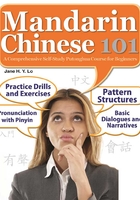
Lesson Three
Nǐ Jiào Shénme Míngzi?
Dialogue I
(David (Dàwèi) introduces his friends to Mary (Mǎlì))

Read the following passage and say whether each of the statements is true or false.
Wǒ jièshào yīxiàr, wǒ jiào Mǎlì. Zhè shì wǒ de hǎo péngyou, tā jiào Dàwèi. Nà shì Déhuá, tā shì Dàwèi de dàxué tóngxué. Wǒ de gēge jiào Yuēhàn. Déhuà yě rènshi wǒ de gēge, tāmen yě shì dàxué tóngxué. Wǒ hé Dàwèi qù wǒ gēge jiā.Déhuá hé tā de nǚpéngyou Lìměi yě yīqǐ qù. Wǒmen tài gāoxìng le.

Vocabulary

Notes
1 “Wǒ jièshào yixiàr” (let me introduce…) is a common expression for introducing somebody. Yīxiàr means that an action will be of short duration or something will be done in a casual way. Here the second meaning is intended.
2 ‘Wǒmen yīqǐ qù ba!’ Here ‘ba’ is put at the end of the sentence, making the tone of the much softer.
3 -er is often added to another final to make it retroflexed. The retroflex final is transcribed by adding ‘-r’ to the original final. E.g. wánr (to play), huār ( flower).
4 When a personal pronoun or a noun is used to indicate belongingness, it generally takes the structural particle ‘de’ . E.g. tā de shū, wǒ gēge de jiā.
5 “Tài hǎo le” is an expression used to show satisfaction or admiration. The word “tài” signifies a very high degree of such sentiments.